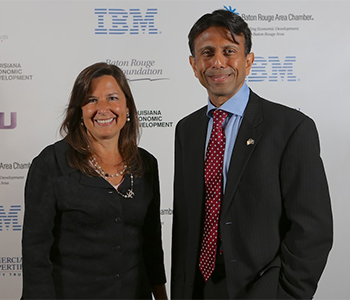
Documents were filed in East Baton Rouge this week finalizing the sale of the former home of newspaper The Advocate in downtown Baton Rouge to Lafayette Street Holdings for nearly $4.1 million. Good thing, since IBM today is holding a groundbreaking ceremony for its new 800-job service center on the property, where the Baton Rouge Area Foundation has committed to build and manage the $55-million total project through its affiliates, the Wilbur Marvin Foundation (which largely controls Lafayette) and Commercial Properties Realty Trust.
That project, announced earlier this year, is part of a strategy by IBM to drive economies of scale, said Cameron Art, general manager, Application Management Services North America, for IBM Global Business Services, during a presentation two weeks ago in Atlanta at the Momentum 2013 conference. It’s doing the same at centers in Lansing, Mich., and Halifax, Nova Scotia.
As other speakers at the conference noted, the IBM projects are in turn part of a larger opportunity sometimes lost amidst the buzz to bring offshored manufacturing back to North America — the potentially more lucrative chance to bring back outsourced services that also went offshore.
Whoa … aren’t offshoring and outsourcing the same thing?
In today’s shorthand-soaked media culture, you’d be forgiven for thinking so. But they’re not synonymous. Outsourcing is simply the farming out of services by one company to another, whether the “outsourcee” is domestic or not. Offshoring is the sometimes overlapping practice that means those services will be delivered by people working in non-US locations.
Companies and communities are beginning to open their eyes to the idea of keeping this business at home, even if it’s outside a company’s walls, said a number of people at the Momentum meeting, which billed itself as “the inaugural conference solely dedicated to U.S. domestic sourcing (onshoring) of IT and BPO services.”
“We provide online tools to over 20,000 schools in North America,” said Mike Heeter, director of Web applications and architecture for Jostens, which has used domestic outsourcing for the past seven years. “We leveraged India heavily in the 1990s when we were doing ERP integrations. Recently we’ve moved away from India. It used to be all about costs. That made the accountants happy. But in order to support that, we needed multiple on-site resources at higher cost. And then there was the intangible cost — communication barriers, time zones. It was a drain on staff and on people’s personal lives, with calls at 7 a.m. and 9 p.m.”
Thomas Mirc, manager, global product and customer systems, for Red Hat, attested to a similar experience. It all depends on how you evaluate total cost of ownership.
“Red Hat has built up a presence in Pune, India,” he said, and has tried to build up supporting functions there, motivated primarily by cost savings. “We ran into similar challenges. The economics are very favorable, but as you look at support and coordination functions, it’s turned out to be unfavorable from a cost perspective. So we’ve started to aggressively pursue domestic sourcing options.”
“Integrating domestic sourcing is something you are going to continue to see more and more of,” said Eugene Kublanov, managing director, Shared Services & Outsourcing Advisory, KPMG LLP, who has watched with interest the reshoring of manufacturing and the inherent flexibility and speed such moves have brought back to the companies who have done it. “This is the right time to do it,” he said. “If we’re seeing these types of trends in high tech and textiles coming back to the US, certainly the opportunity for domestic sourcing is as great, if not greater.”
Overcoming the Cost Obsession
Believe it or not, said HfS Research founder and CEO Phil Fersht, just when you thought big corporations already had farmed out everything they can in order to get lean, recent survey results belie that assumption. A study conducted earlier this year in partnership with KPMG found that 40 percent of respondents still run payroll in-house.
“You’d have thought, in these days of ADP, who wants to do payroll anymore?” Fersht said, confessing to having been surprised himself. “Get down to accounts receivable, and it’s 52 percent in-house,” he said, with only one in five respondents taking care of AR via a shared services operation.
“Why do only 22 percent run finance and accounting in shared services?” he asked. “Companies are really struggling to let go. It doesn’t mean this market is set to explode. But so much stuff is still run in-house.
“It’s very timely to have this conversation,” he told the Momentum audience, comprising corporate managers, outsourcing firms looking to serve them, and economic developers looking to serve both. “We’re close to an inflection point. Most of the stuff that’s been outsourced to date has been relatively low-end work — payables, receivables, health-care claims. A lot is outsourced to India and Latin America. What hasn’t transpired is mid- to high-level work being outsourced. That’s where I think the opportunity is for the US service provider picking up high-level projects from clients.”
Examples of successful partnership include Hudson’s Bay Co.’s growing use of Onshore Outsourcing, based in the small northeastern Missouri town of Macon. Another domestic outsourcing firm, Rural Outsourcing, was launched by CEO Monty Hamilton in rural Arkansas. He now operates a second location in Augusta, Ga., and is actively searching for a third.
“People always ask us about the scalability challenge,” said Charles Ruggiero, President and COO, Onshore Outsourcing, of concerns about running out of talent in rural locations. In fact, he has.
“We’ve effectively run out of runway in Macon, Missouri,” he said. “When we started in Macon, unemployment was between 8.5 percent and 9 percent.” In such a small community, each time Onshore hired 50 more people the blip in the graph was significant. “Now it’s down to 5.6 percent,” he said. “We are running out of workers. So we’re having to expand.”
Happily, in a sense, the US is not running out of small-town locations where people are looking for work. Onshore is now growing at a college campus location in Glenville, Ga., where the unemployment rate is 10.6 percent. “So we’ll do just fine there,” said Ruggiero.
Currently, said Fersht, HfS estimates that around 20 percent of global business process outsourcing (BPO) and IT spend goes to the US.

Ahilia, Inc.
Other results of the survey pointed to two trends now afoot: a desire to work with outsourcing partners on innovation and change management (rather than a soul-draining total focus on cost reduction); and a desire to access talent in analytics and compliance.
“We had a meeting with 50 buyers,” said Fersht, “and asked them, ‘How many of your leaderships are obsessed with costs?’ And 73 percent said they were. I think the obsession with cost overrides value.”
He thinks the projected 300,000 surplus office workers in the US by 2020, including large numbers of what he called “data scientists,” will be primed to provide that value, and at a not unreasonable price.
According to the IfS/KPMG survey of 200 enterprises, company leaders asked what level of cost savings they’d need to achieve to move work to various countries said 28 percent for China and India (down from 40 percent several years ago). For the US, they only needed to see 17-percent savings to justify the move. But some are seeing more.
“We’re actually saving 30 percent with our US sourcing,” said Mike Heeter of Jostens, with the added bonus of flexible and agile development teams working on short turns as new versions of his team’s online tools get released more frequently.
Don’t Worry, Get Busy
Amrita T. Joshi, CEO of Momentum conference organizer and consulting firm Ahilia Inc., says outsourcing has been largely ignored for a couple reasons.
“One is they think outsourcing is a bad word,” she said. “The second reason is the big push with manufacturing, which is fantastic, but there is literally zero focus on the knowledge services industry. It’s ignored. It’s also because of a lack of awareness and education about this industry,” she said. The proof? “When we have to explain what we do to our relatives.”
Joshi and others hoped to use the conference as a catalyst toward forming an association dedicated to US outsourcing.
“We are one of the only countries that does not have an organization to promote it,” she said, noting that the US represents “42 percent of the dollars spent on global outsourcing, and we need more of it here.”

“I think the obsession with cost overrides value.”
Some of the outsourcing opportunity is coming from foreign companies, including Indian firms such as Tata, whose TCS subsidiary was a pioneer of sorts in offshoring from India to the US as early as the 1980s.
Ron Hira, associate professor of public policy at Rochester Institute of Technology and co-author of the book “Outsourcing America,” has been a persistent thorn in the side of those who insist that offshoring ultimately benefits US companies and, therefore, America as a whole.
The typical company line, he told the Momentum audience, is that “there will be winners and losers, some people will get displaced, and some companies will lose, but the gains we have will be larger than the losses, and the winners can theoretically pay off the losers. But the reality is that the US can be a net loser overall. I think white-collar offshoring is a bigger threat, because it threatens higher paying jobs. We should be worried about this. But ‘Don’t worry, be happy’ is really the consensus in Washington among the elites.”
Company line No. 2 goes like this: Offshore the low-level kind of work, and the US will retain the creative, innovative, high-level, high-skill jobs. Exhibit A for this theory, he said, is the iPad: designed in Cupertino, Calif., and made by Foxconn in China. But that doesn’t make the theory uniformly true across all sectors. “Many people in this room,” Hira said, “know in fact there is some high-level stuff going offshore.” He held up R&D investment in China as an example:
“Nobody really knows whether that’s because China required you set up an R&D facility in China to take advantage of the labor, or whether the content coming out of that research is of value,” he said. But the larger point is more important, he said. “You have countries like India and China that realized innovation matters.” Over and above capturing the R&D, he said, “it signals they have the absorptive capacity to upskill.”
Numbers Are Great, Understanding is Greater
Does the United States? Hira thinks so. But the first hill to climb (besides Capitol Hill) is with community leaders.
“A lot of economic development people are interested in the sexier industries,” he said. “BPO is not as interesting as video games.”
Tell that to the people in Baton Rouge, a location which now has welcomed major investments in both video games and IT services, from EA Sports and IBM, respectively. IBM’s Cameron Art said the positive impression his team got from Louisiana Economic Development, their LED FastStart training arm, Louisiana State University and Baton Rouge included EA.
“They brought the EA guys in to spend time with me, because I was testing the scale question,” said Art. “FastStart was adept at saying ‘Here’s your [labor] pool size,’ and could get into specifics, and it didn’t seem like a foreign language to them. A lot of the economic developers in the past have not been focused on labor and people as much as on assets and factories.”
The people employed by IBM’s first such center in Lansing now number between 500 and 600. Baton Rouge will total between 800 and 1,000 when it reaches build-out, in part because LSU and others are doing their part to educate more students in computer science and related fields. While there were various other incentives IBM is taking advantage of, said Art, the talent is the biggest incentive of all. He found that out on his team’s initial forays to Louisiana, when the strategy was still mostly based on looking for states with higher unemployment and with college towns that might be looking to retain more graduates.
“In the state of Louisiana, if you graduate with a 2.5 GPA and a 21 on your ACT, they’ll pay for you to go to a state school,” said Art. “So guess what? We went to visit other states. We went to a big Midwestern state, and they showed us the campus, and said, ‘We have 22,000 undergrads.’ We left that meeting and went to Louisiana. Somehow we got on the topic of this program. We were talking about a community college, and somebody said, ‘22,000.’ I said, ‘Back up, did you say 22,000 at a community college? How many are at LSU?’ They said 44,000.
“So what you start to see is they’re redirecting their economic development towards people, and not plants and assets,” said Art. “We are going to provide a bunch of technology, but what we really want is people.”

